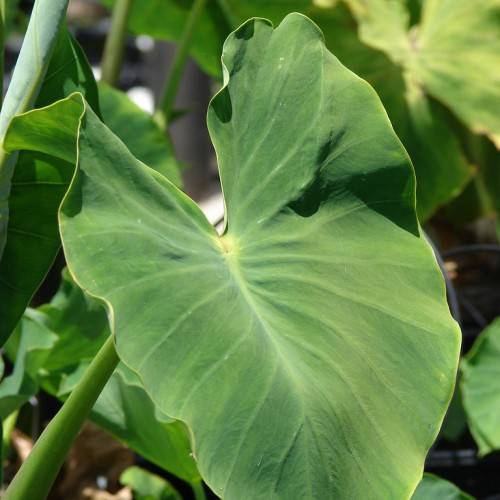
taro
Colocasia esculenta
Also Known As - coloyam,elephant's ear,elephant's earCycle:
Perennial
Watering:
Frequent
Hardiness Zone:
8 - 10
Flowers:
Flowers
Sun:
full sun,part sun/part shade
Soil:
Acidic, Bog, Humus rich
Fruits:
Fruits Ready In Fall
Edible:
Yes
Leaf:
Yes
Growth Rate:
Low
Maintenance:
Moderate
Drought Tolerant:
Yes
Salt Tolerant:
Yes
Invasive:
Yes
Tropical:
Yes
Care Level:
Medium
watering
Taro (Colocasia esculenta) should be watered regularly, ideally every 3-4 days, to a depth of approximately 6 inches. The soil should be kept consistently moist and the upper inch of soil should feel moist to the touch, but not overly damp or soggy. During the hot months of summer, the taro may require slightly more frequent waterings. It's important to ensure that water can penetrate the soil deeply, so make sure that the soil is not overly compacted. Lastly, be sure to check the plant's foliage regularly for signs of dehydration, such as curling, wilting, or yellowing leaves.
sunlight
Taro requires at least 6 hours of direct sunlight each day in order to thrive. Ideally, it should receive 8 to 12 hours of sunlight a day for optimal growth. It's important to ensure the taro receives the necessary sunlight during the peak hours within the day, which typically tend to be in the morning and early afternoon. Additionally, it may require some shade during the hottest part of the day. For best results, it is recommended that you ensure that your taro is in an area that receives plenty of sunlight and has some access to shade.
pruning
Pruning of taro (Colocasia esculenta) should be done annually in late summer or early fall. Pruning should be done before the foliage yellows and dies off. An effective pruning regime involves removing old, dying or damaged leaves, stems, and roots, as well as any excess or vigorous growth that can reduce air movement and light penetration. Aim to remove up to 1-third of the older or damaged foliage and thin any overcrowded crowns. Also consider promoting new leaf and stem growth by removing the oldest part of the clump; divide and replant every 3 to 4 years.
